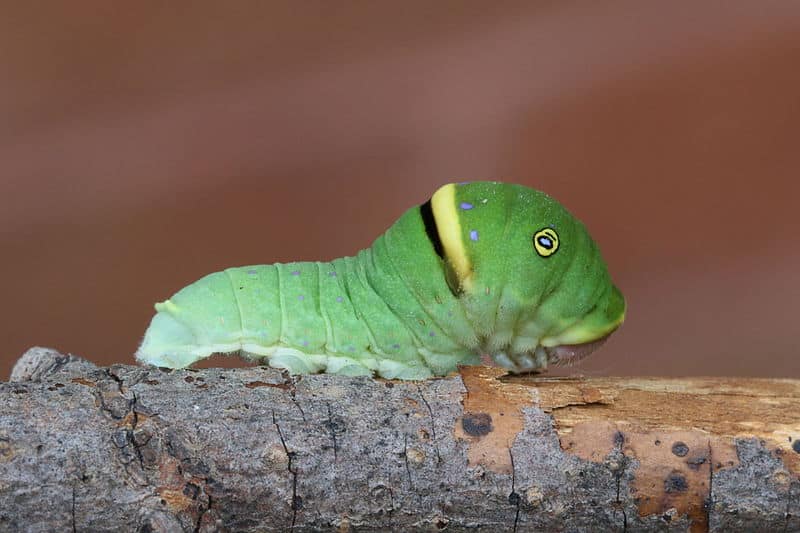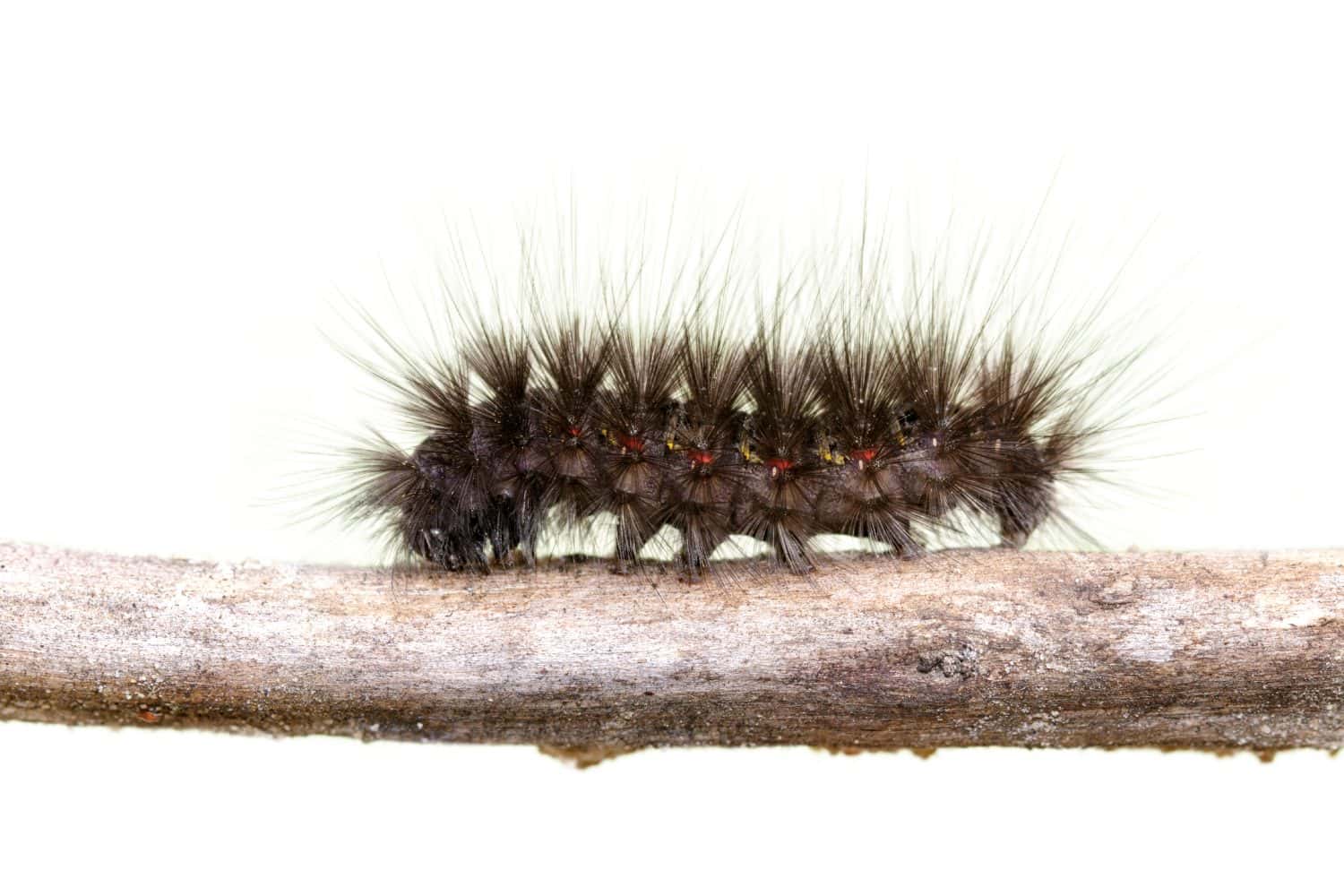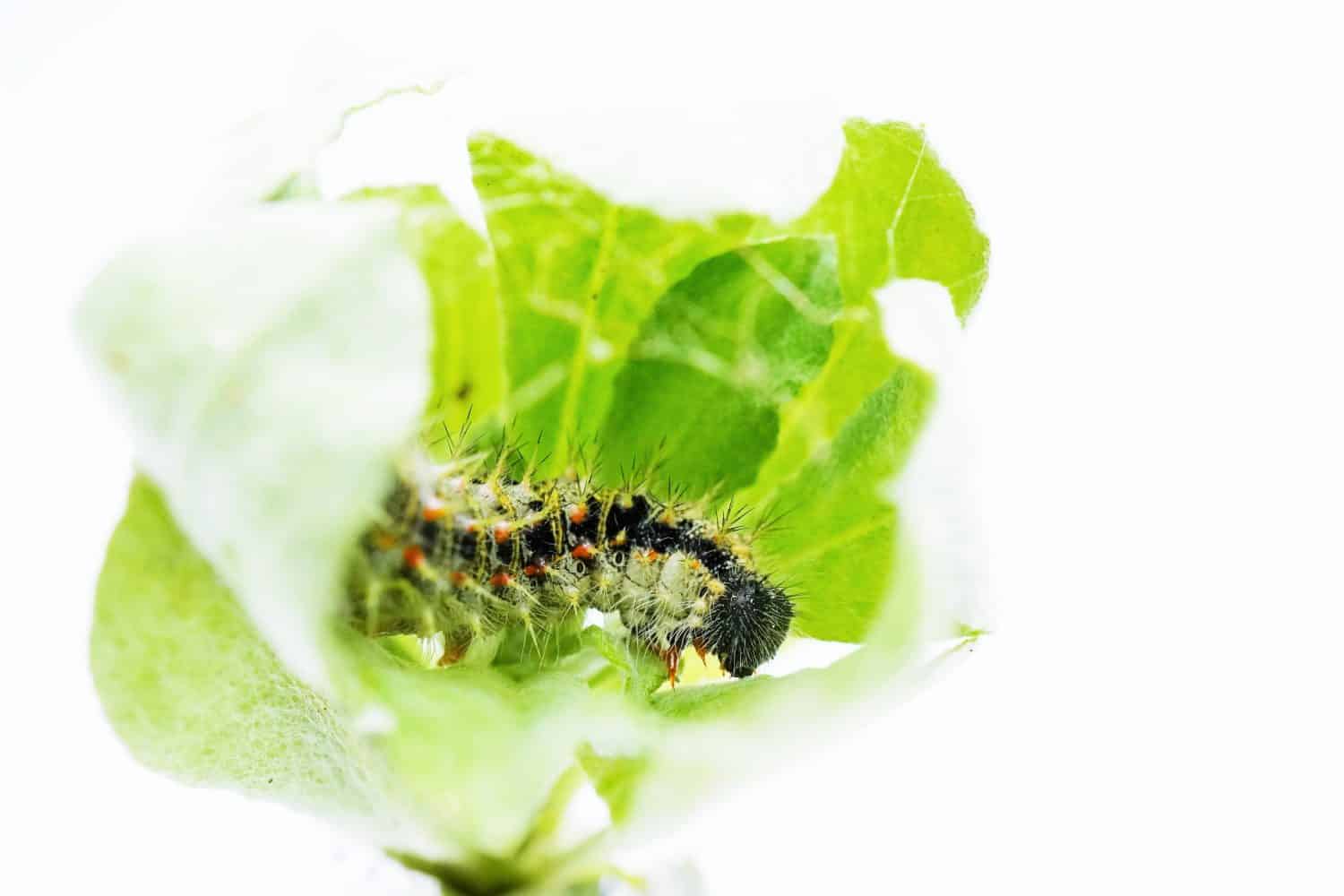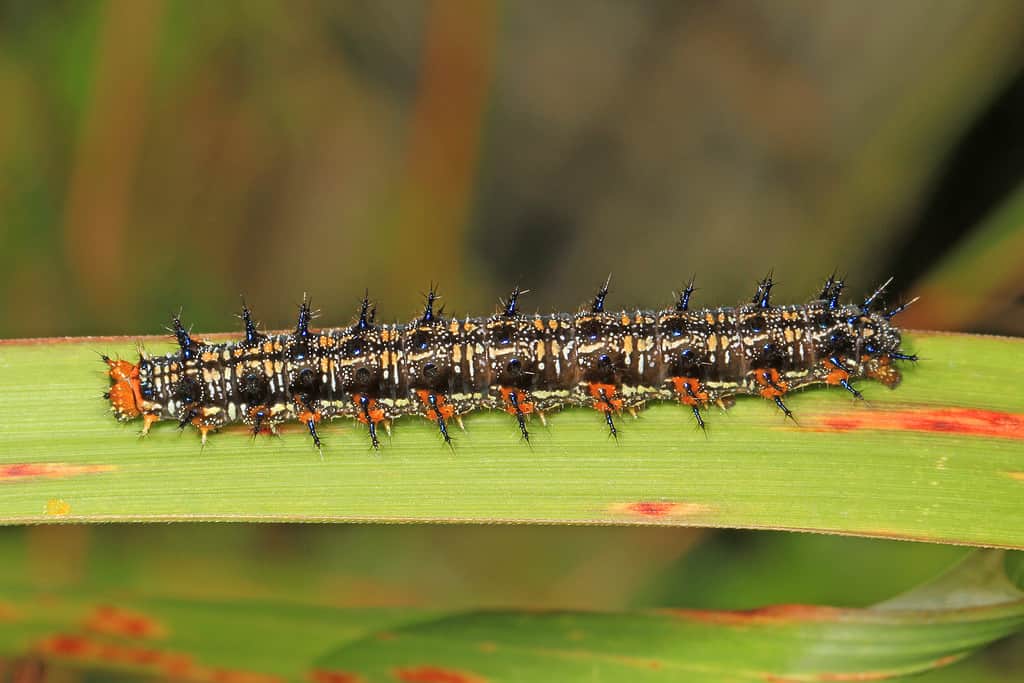Over 130 different types of caterpillars can be found throughout Canada! They vary widely in size, color, diet, habitat, and stinging capacity. Below, we’ll take a closer look at eight of the most unique and interesting types of caterpillars in Canada, as well as a few that are even able to sting potential predators (and unsuspecting humans) with their spines!
1. Cattail Caterpillar (Acronicta insularis)

Cattail caterpillars primarily feed upon cattails and are largely harmless to humans.
©Jacy Lucier / CC BY-SA 4.0 – License
This unique-looking species is the larval form of the Henry’s marsh moth. In addition to living throughout southern Canada, it can also be found all across the United States. True to their common name, these caterpillars feed on cattails, as well as knotweed and various other types of grasses and flowering plants.
Fortunately, despite its rather intimidating appearance and boldly colored spines, it isn’t dangerous or poisonous. It can be easily identified by its dark greenish and pale yellow mottled body and bright orange spots from where its long, hair-like dark green and white spines protrude.
2. Canadian Tiger Swallowtail Caterpillar (Papilio canadensis)

The Canadian
tiger
swallowtail’s larval form has an enlarged head with false eyespots.
©Cephas / CC BY-SA 4.0 – License
This bizarre-looking caterpillar has an almost snake-like appearance to ward off predators! It’s the larval form of the Canadian tiger swallowtail butterfly. The adult form of this caterpillar eventually grows to have an impressive wingspan of up to 80 millimeters. You can find this caterpillar throughout all of Canada’s provinces. Its favorite foods are birch trees, poplars, aspen trees, and cottonwoods, as well as the leaves and bark of apple and black cherry trees.
Despite its large size and rather uncanny, snake-like eyespots, this caterpillar is also harmless to humans. Like with most caterpillars, though, it’s best to avoid handling them to prevent frightening or damaging them. It’s easily identifiable thanks to its bright green hue and a massive head with yellow and black eyespots. They also have a yellow and black horizontal stripe just behind their eyespots.
3. Northern Pine Tussock Caterpillar (Dasychira plagiata)

Northern pine tussock caterpillars can cause itchy rashes with their spines.
©yod 67/Shutterstock.com
The northern pine tussock caterpillar mainly lives throughout Alberta and Ontario as well as much of the northern half of the United States, particularly in the Northeast. When fully mature, it boasts a wingspan of around 35 millimeters.
If you encounter one of these caterpillars, it’s a good idea to keep them at a safe distance from you and your pets. This is because the long hair-like spines can cause a rather painful, itchy rash and raised, reddish bumps on one’s skin if touched.
As their name suggests, these caterpillars feed primarily on spruce, fir, and pine trees. Additionally, they occasionally feed on hemlock trees.
4. Cecropia Moth Caterpillar (Hyalophora cecropia)

Although it is harmless to humans, the Cecropia moth caterpillar’s brightly-colored bulb-like spines give it a downright eerie look.
©K Hanley CHDPhoto/Shutterstock.com
This particular caterpillar has an alien-like appearance, with a neon green body and bright orange and blue bulbous protrusions adorned with tiny black spikes. Fortunately, despite these intimidating spines, they are not poisonous, nor are they able to sting. However, many potential predators still avoid eating the caterpillar solely due to its frightening coloration and appearance. Interestingly, the caterpillar’s adult form lacks this bright coloring altogether. Instead, its mature form has a mostly brown and tan body coloration.
Cecropia moths and their larval caterpillar forms live throughout North America, including most of Canada’s provinces. Interestingly, its adult form is the largest native moth species in all of North America! They mostly feed on maple trees as caterpillars, but they also occasionally feed on birch and cherry trees.
5. Painted Lady Caterpillar (Vanessa cardui)

The spines of the painted lady caterpillar are actually harmless.
©cattosus/Shutterstock.com
This handsomely-colored caterpillar is the larval form of the most widespread butterfly species on the planet! When fully mature, it boasts an attractive orange and black coloration with small black and white spots. Its larval form, however, has a mottled black and green coloration with long, hair-like white and black-tipped spines. Despite their spiky, edgy look, they’re actually perfectly safe to handle–though you probably shouldn’t do so to prevent injuring them.
Incredibly, the painted lady caterpillar lives on every continent except Antarctica and South America. As larvae, they mainly feed on thistle plants. Because of this, they’re also sometimes known as thistle caterpillars.
6. Red Admiral Caterpillar (Vanessa atalanta)

This group of red admiral caterpillars are feeding upon their preferred host plant: stinging nettles.
©ABS Natural History/Shutterstock.com
The red admiral caterpillar and its adult butterfly form are found throughout southern Canada and much of the more temperate regions of the United States. Additionally, it can be found in parts of Europe, Asia, and the Caribbean. During the spring and autumn months, they typically migrate north.
As an adult, its wings are black with prominent deep orange or reddish stripes. Its larval form is easy to identify by its deep black coloration with white spots and spines. Despite the intimidating appearance of these spines, they’re not poisonous and are safe to handle. They measure around one inch long. Red admiral caterpillars mainly feed on stinging nettle plants.
7. European Gypsy Moth/Spongy Moth Caterpillar (Lymantria dispar dispar)

Gypsy moth caterpillars have very long, poisonous spines.
©iStock.com/grannyogrimm
You’ll definitely want to keep a safe distance from the caterpillar form of the European gypsy moth, as its long hair-like spines can sting! They can actually cause a painful, itchy rash similar to that of the aforementioned tussock caterpillar. These strange-looking caterpillars have a wide geographic range that includes parts of Canada, North America, Europe, and even Africa.
The black and white hair-like spines of the European gypsy moth caterpillar are impressively long and spiky. Its body has a mottled yellow, black, and white coloration with dark orange spots. Meanwhile, its head is more of a pale yellowish-mottled color.
8. Common Buckeye Caterpillar (Junonia coenia)

The spines of the common buckeye caterpillar are actually harmless.
©Judy Gallagher / CC BY 2.0 – License
The mature form of the common buckeye caterpillar has large, spooky-looking eyespots on its wings that it uses to ward off predators. Its larval form looks vastly different, however. Though they can vary slightly in color, these caterpillars typically have dark brown or black bodies with white to yellowish mottled markings or stripes running down them lengthwise. Their spines are also dark brown to black in color, sometimes with a bluish tinge. The head of the caterpillar is usually reddish-orange with small black markings.
Despite their painful-looking spines, these caterpillars are harmless if you come in contact with them. They feed on all sorts of plants, including plantains, foxgloves, and petunias.
The photo featured at the top of this post is © K Hanley CHDPhoto/Shutterstock.com
Thank you for reading! Have some feedback for us? Contact the AZ Animals editorial team.






